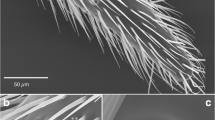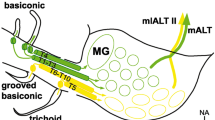Abstract
We have documented odor responses of all morphological classes of sensilla on the surface of theDrosophila antenna: sensilla basiconica, sensilla trichodea, and sensilla coeloconica. Both subtypes of s. basiconica, large and small, respond to odors. S. trichodea fall into different functional types. Type 1 appears narrowly tuned, as it responded only tocis-vaccenyl acetate, believed to be a pheromone. Type 2 responded totrans-2-hexenal and 4-methyl cyclohexanol. These two types of s. trichodea are differentially distributed on the antennal surface, and have dramatically different frequencies of spontaneous action potentials. Likewise, there are multiple types of s. coeloconica. One type is broadly tuned, responding most strongly to a test stimulus of butyric acid, but also to a variety of other odors; it is restricted to the dorso-medial portion of the third antennal segment. A second type gave detectable responses only totrans-2-hexenal. These results demonstrate that all classes of sensilla are olfactory, and they reveal the organizational complexity of theDrosophila olfactory system.
Similar content being viewed by others
References
Ayer, R. K. and Carlson, J. (1992) Olfactory physiology in theDrosophila antenna and maxillary palp: acj6 distinguishes two classes of odorant pathways.J. Neurobiol.,23, 965–982.
Bartelt, R., Schaner, A. and Jackson, L. (1985)cis-Vaccenyl acetate as an aggregation pheromone inDrosophila melangogaster.J. Chem. Ecol.,11, 1747–1756.
Carlson, J. (1996) Olfaction inDrosophila: from odor to behavior.Trends in Genetics,12, 175–180.
Ferveur, J., Cobb, M. and Jallon, J. (1989) Complex Chemical Messages inDrosophila. InNeurobiology of Sensory Systems, ed. R. Singh and N. Strausfeld, pp 397–409. New York: Plenum.
Den Otter, C. and Van Der Goes Van Naters, W. (1993) Responses of individual olfactory cells of tse-tse flies to phenols from cartle urine.Physiol. Entomol.,18, 43–49.
Guerin, P. and Stadler, E. (1982) Host odour perception in three phytophagous Diptera- a comparative study.Proceedings, Fifth International Symposium on Insect-Plant Relationships, 95–105.
Guillet, J. and Bernard, J. (1972) Shape and amplitude of the spikes induced by natural or electrical stimulation in insect receptors.J. Insect Physiol.,18, 2155–2171.
Gupta, B. and Rodrigues, V. (1997)atonal is a proneural gene for a subset of olfactory sense organs inDrosophila.Genes to Cells,2, 225–233.
Hekmat-Scafe, D., Steinbrecht, A. and Carlson, J. (1997) Co-Expression of two odorant-binding protein homologs inDrosophila: Implications for Olfactory Coding.J. Neuroscience,17, 1616–1624.
Helfand, S. and Carlson, J. (1989) Isolation and characterization of an olfactory mutant inDrosophila with a chemically specific defect.Proc. Nat. Acad. Sci. USA,86, 2908–2912.
Riesgo-Escovar, J., Piekos, B. and Carlson, J. (1997) TheDrosophila antenna: ultrastructural and physiological studies in wild-type and lozenge mutants.J. Comp. Physiol. A,180, 151–160.
Riesgo-Escovar, J., Raha, D. and Carlson, J. (1995) Requirement for a phospholipase C in odor response: overlap between olfaction and vision inDrosophila.Proc. Natl. Acad. Sci. USA,92, 2864–2868.
Siddiqi, O. (1987) Neurogenetics of olfaction inDrosophila melanogaster.Trends in Genetics,3, 137–142.
Siddiqi, O. (1991) Olfaction inDrosophila. InChemical Senses, ed. C. Wysocki, and M. Kare, pp. 79–96. New York: Marcel Dekker, Inc.
Stocker, R. (1994) The organization of the chemosensory system inDrosophila melanogaster: a review.Cell Tissue Res.,275, 3–26.
Venkatesh, S. and Singh, R. (1984) Sensilla on the third antennal segment ofDrosophila melanogaster meigen.Int. J. Insect. Morphol. Embryol.,13, 51–63.
Author information
Authors and Affiliations
Corresponding author
Rights and permissions
About this article
Cite this article
Clyne, P., Grant, A., O'Connell, R. et al. Odorant response of individual sensilla on theDrosophila antenna. Invertebrate Neuroscience 3, 127–135 (1997). https://doi.org/10.1007/BF02480367
Accepted:
Issue Date:
DOI: https://doi.org/10.1007/BF02480367




